Cult TV
Cult TV was a UK monthly magazine that began in August 1997, and a sister magazine to SFX. It lasted just 11 issues, with confusing numbering. The 1997 issues started "season 1 episode 1" to "episode 5"; the 1998 issues were "season 2" for 5 more "episodes"; the final June 1998 issue was 11. There was also a preview issue as an extra in SFX.
The title was also similar to contemporary British magazine Cult Times, a sister title of Starburst and TV Zone that focused around TV and satellite listings since 1995.
Cult TV had brief listings and reviews for TV and satellite shows, and wider coverage than just science fiction, including comedy, drama and kids cartoons, mixing nostalgia and contemporary hit television.
The first issue had a Lady Penelope cover and Gerry Anderson interview, and the "season 2 episode 4" (April 1998) issue had a four page Space: 1999 feature.
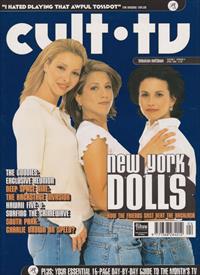
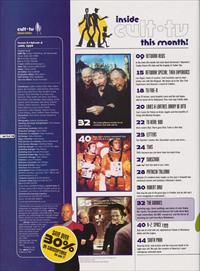
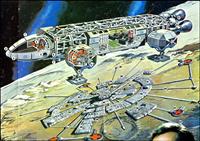
The highlight is the cutaway art of the Eagle by Graham Bleathman, who has done cutaways of many other Gerry Anderson series, and would later contribute to the Unstoppable sketch cards. Bleathman's signature is hidden behind Landau's forehead. The side text reads "Note: this map of Moonbase Alpha and plan of an Eagle are an interpretation. They are in no way official or connected to Polygram. No copyright infringement is intended." It has been reprinted twice in other SFX spin-off magazines (see below): SFX Collection #37, TV Sci-Fi Classics (Dec 2007, p64-65) and The Ultimate Guide To Sci-Fi Robots and Spaceships (Oct 2015, p126-127). Unfortunately, every version of this art has been printed across the page break.
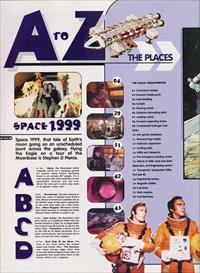
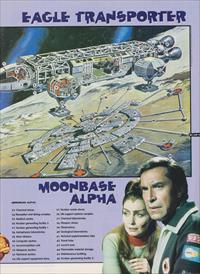
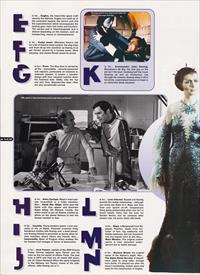
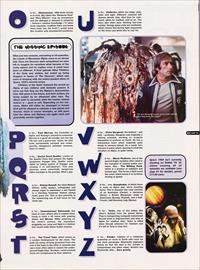
The A-Z article is a jokey gimmick, and seems to have been cribbed from the internet. At least several bits definitely come from the Catacombs, but the typos and errors obviously came from other sites... Best new "fact": "Kano has the hots for Sandra Benes"
Space 1999, that tale of Earth's moon going on an unscheduled jaunt across the galaxy. Flying the Eagle on a tour of the Moonbase is Stephen D Pierce.
A is for... Alpha, the Moonbase which originally serves as a dumping ground for nuclear waste before becoming home to an unlucky 327 people. It's a vast complex with such amenities as the gymnasium, Solarium and rest area where the crew get to paint, play cards or do jigsaws. Crazy, man.
B is for... 'Breakaway', the pilot episode in which the moon is blasted from Earth's orbit. Return to Earth isn't possible due to the limited range of the base's spacecraft, so the crew must seek out a new home. Also... Moon Buggies. Whenever nuclear juice starts seeping, it's straight into these Banana Splits vehicles to patch it up.
C is for... Alan Carter, the Australian chief pilot. Carter is a handsome fellah who can handle himself in a fight, fly an Eagle better than anyone (see E) and has an eye for the ladies. Also... Commlock, a device carried on the belt by all Alpha personnel. It's a video communicator and electronic key to doors all Over the lunar complex.
D is for... Dark Side of the Moon. The area of the moon where the nuclear waste was stored. Also... The Dorcons, who cause serious aggro when they arrive and demand Maya's brain stem, an acquisition that would allow them to live forever. Worth a try, I suppose.
E is for... Eagles, the insect-like space craft used by the Alphans. Eagles are made up of the command module, the service pod and the superstructure which encompasses the landing gear, main fuel tanks and boosters. The service pod is interchangeable and is altered depending on the mission, such as transporting, rescue or reconnaissance.
F is for... Funky music. Whenever there's call for a bit of hand to hand combat, the slap bass and drum kit go into overdrive as Koenig et al get thrown around by a horned beast. Most amusing, and James Brown would be proud.
G is for ... Guns. The Stun Gun is carried by all the - expendable - security personnel and regulars, particularly on missions to unknown planets. It boasts a peculiar design with four coloured nodules down the business side. Oddly, only the top one ever fires. Bazooka-like laser rifles are also occasionally carried.
H is for... Hairy Cyclops, Maya's most popular incarnation in a tricky situation. Also... Hawk War Ships, three year-old Earth craft that appear and decimate Alpha killing 130 Alphans. Luckily, the entire event is just an illusion created by aliens on the planet Deimus to test the human reaction to fear.
I is for... Insanity. Going bonkers seems a pre-requisite of life on Alpha. Paranoid crewman Greg Sanderson battles with Koenig over a dead planet, and Koenig himself is perceived as barmy when he sees monsters where others see friends. Also... Immortality. Balor of Progron offers endless life for freedom but reneges in favour of destruction.
J is for... Jack Tanner, captain of the 1986 Uranus Probe. Koenig happens upon Tanner and his crew on the ice planet of Ultima Thule. The year here is 2870 and they are all nearly 900 years- old. Dr Cabot Rowland offers the same longevity to the Alphans, but Tanner. aware of the side- effects, talks Koenig out of it.
K is for... Commander John Koenig, Moonbase's Mr Big. His first day on the job isn't the best, involving half the moon blowing up and an involuntary trip through the cosmos. Koenig takes it all in his stride, a permanent beacon of hope in an otherwise bleak situation.
L is for... Love interest. Russell and Koenig provide the stable relationship - although you rarely see them at it. Maya and Tony have your typical on-off, tempestuous thing going (presumably when she isn't a lizard beast). Kano has the hots for Sandra Benes, but he vanishes after season one, his score sheet still blank.
M is for... Maya, a Metamorph from the planet Psychon. Aside from her tower of hair, big sideburns and blobby eyebrows, she can transform into any organic form at will. Also... Main Mission. The original control centre is later relocated under- ground due to battle damage.
N is for... Nuclear Waste, the original cause of the Alphan's plight. Also... The Alpha News Service. A depart- ment used to relay video footage from Earth, it's phased out after the moon's breakaway, broken down and used for the construction of Eagles.
O is for... Obviousness. 1999 deals strictly in lo-tech. Big labels like 'Weapons Rack' and 'Main "Mission' crop up everywhere and the dialogue is steeped in simplicity - Helena's medical knowledge ("It takes brain impulses, modifies them and feeds them back into the brain") would leave Bev Crusher with unanswered questions.
After just two seasons, amounting to 48 episodes, the travels of Moonbase Alpha came to an abrupt halt. Once the Dorcons were vanquished we were left to imagine for ourselves what became of the rocky sphere and its captive crew. It could have been so different. A final episode titled 'Children of the Gods was written, but ended up being dropped in favour of 'The Dorcons'; which was more in keeping with the action-packed ethos of Space 1999's second series.
'Children of the Gods' featured the arrival on Alpha of two children with fantastic powers. It turns out that they are the Alphan's descendants from 300 years in the future, and their actions are being judged by an advanced alien race. The aliens wish to ascertain what the human natural instinct is - good or evil. Depending on the out- come, Alpha will either be destroyed or human kind will be allowed to colonise a new planet and flourish. Good of course triumphs, so 300 years later the aliens and Alphans can again meet and peacefully coexist together.
P is for... Paul Morrow, the Controller of Alpha and Koenig's second-in-command. Morrow is a good all-rounder, but has big 70s hair and a porno-star 'tache. He also looks permanently annoyed and conse- quently, disappears between seasons, never to return.
Q is for... Doctor Ernst Queller, creator of the Queller Drive that powers the highly dangerous Voyager One. Queller saves Alpha by taking control of Voyager and causing it to self-destruct. This also destroys some potentially dangerous Sidon warships in the process. What a guy.
R is for... Helena Russell, the Chief Medical Officer, softly spoken, unflappable and always eager to administer a wet flannel to a bleeding forehead. Helena always looks great too. This is due primarily to the unswerving use of soft focus for her close-ups.
S is for... Commissioner Simmonds, the head of Luna affairs who is wasted when trying to hitch a lift home with passing aliens; and Slo-mo. While pottering on the moon's surface, the characters sluggishly run, jump and fight in a fashion that would make Steve Austin envious.
T is for... The Travel Tube, which serves as a London Underground for the moon. The pods zip along carrying personnel from one end of the base to the other in seconds and were most often used to access the under- ground Eagle bays. Drunken, vomit-covered loons are conspicuous by their absence.
U is for... Uniforms, which are beige, poly- ester and tight. Different coloured left sleeves denote duty: dark blue for com- mand, white for medical, and so on. The stars also often wear fetching two-tone cardies. Orange space suits are numbered, which means that during fight sequences on the moon you know who to root for.
V is for... Victor Bergman, the brilliant - and bald - professor. Bergman was originally a visiting scientist, working on projects impossible to perform on Earth. He has a mechanical heart which responds quite slowly to nervous stimuli. As a result, he's immune to panic which, bearing in mind the situation on Alpha, is quite handy.
W is for... Winch Platform, one of the special Eagle modules often used in the transport of nuclear waste canisters. Also... The Wilding Field, which is a product of radiation and ionised gas. This forms a field round the moon which forces it to continue moving at speed.
X is for... erm, Xenophobia, of which there is none on Alpha (yes, we're reaching here). This is because the crew consists of an Australian (Carter), a Jamaican (Kano), a Britain (Bergman), loads of Americans (Koenig, Russell), and a half- French, half-Burmese lady (Benes).
Y is for... Yesta, one of two ladies (the other's Sahala) from the planet Norva. They're transporting renegade metamorph Dorzak back to imprisonment and stop at Alpha for medical help. Yesta is killed when Dorzak schemes for freedom and it's left to Tony to stop him.
Z is for... Zandor, Captain of a Caldorian spaceship en route to Earth with room for one more passenger. Simmonds engineers events so that the seat is his. Zandor is unimpressed and takes steps. Scratch one Simmonds. Also... Zero gravity.
The Bleathman art is reprinted in SFX Collection #37, TV Sci-Fi Classics, December 2007, p64-65. The series summary claims it stars Landau, Bain and someone called Nick Tait. We get two photos from the Cult TV article as well; the same A B Chrysalis shot of Tate and Landau in spacesuits, and the rescue Eagle with exiles pod (from the 1993 Wolverhamption exhibition)

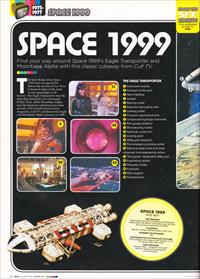
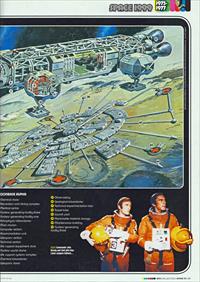
Another SFX special, The Ultimate Guide To Sci-Fi Robots and Spaceships, October 2015, p126-127. An excuse to do a countdown of spaceship designs (and robots), with the Eagle getting to number 9 (just behind the Close Encounters mothership at 8, and the entirely predictable headliners). Again, the Chrysalis shot of Tate and Landau, and the Wolverhamption Eagle with exiles pod, reappear with the Bleathman art. The "Premise" box contains the exact same text as the TV Sci-Fi Classics above, including the Nick Tait star. For such a short description, the text makes several factual errors.
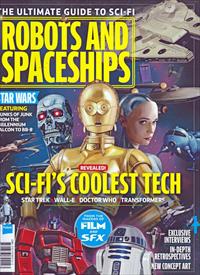
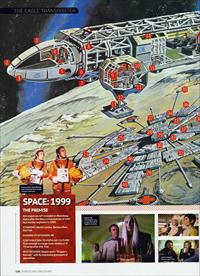
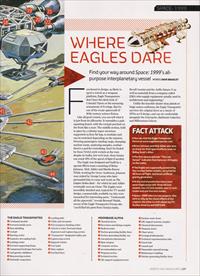
Find your way around Space: 1999's all-purpose interplanetary vessel. Words: DAVE BRADLEY
Functional in design, as likely to sport a winch as a weapons platform, Eagle Transporters don't have the sleek look of Colonial Vipers or the menacing armaments of X-wings. But it's one of the iconic spacecraft of 20th century science fiction. Like all good vessels, you can tell what it is just from its silhouette. It resembles a pale, squatting lizard, with the cockpit perched on the front like a nose. The middle section, held in place by a tubular super-structure supported on four fat legs, is modular and can be switched depending on the mission. Ferrying passengers, hauling cargo, dumping nuclear waste, analysing samples, combat - there's a pod for everything. Don't be fooled by those NASA-style rockets at the rear; despite its bulky, low-tech look, these beasts can reach 15% of the speed of light if needed. The speed is only specified in Starlog's Eagle blueprints; in the show there is no such claim
The Eagle was designed and built by a special effects team consisting of Brian Johnson, Nick Allder and Martin Bower No, it was designed by Johnson and built by a company called Space Models. While working for Gerry Anderson, Johnson was visited by George Lucas who later persuaded him to come and work on The Empire Strikes Back - for which he and Allder eventually won an Oscar Allder didn't work on Empire and didn't win an Oscar for it. Oddly, no mention that the Millennium Falcon was redesigned because the original was too similar to an Eagle. The Eagles were incredibly detailed and, typical for TV model design, commercially available toy kits were ransacked for interesting parts An odd comment about TV models, as it is also typical for movie model design, famously including 2001 and Star Wars. "Underneath all the pipework," reveals Bernard Walsh, owner of the Eagle Transporter Forum site, "you'll find kit parts from Tamiya tanks, Revell Gemini and the Airfix Saturn V, as well as materials from a company called EMA who supply equipment usually used in architecture and engineering."
Unlike the knuckle-duster stun pistols or beige unisex uniforms, the Eagle Transporter survives the original show as a classic of 1970s sci-fi design, and can sit comfortably alongside the Enterprise, Battlestar Galactica and Millennium Falcon.
Space: 1999 copyright ITV Studios Global Entertainment